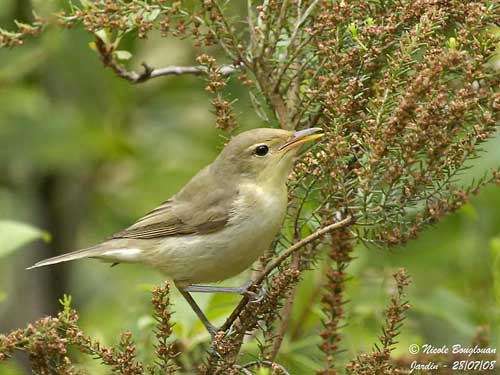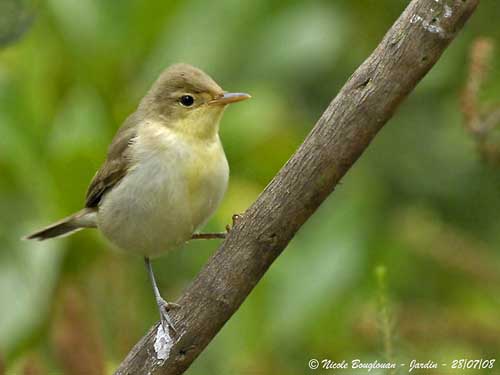
Fr: Hipolaïs polyglotte
All : Orpheusspötter
Esp : Zarcero Común
Ital : Canapino comune
Nd: Orpheusspotvogel
Sd: Polyglottsångare
Photographs and text by Nicole Bouglouan
Sources :
HANDBOOK OF THE BIRDS OF THE WORLD Vol 11 by Josep del Hoyo, Andrew Elliott and David Christie - Lynx Edicions - ISBN: 849655306X
BIRDS OF THE GAMBIA AND SENEGAL by Clive Barlow and Tim Wacher – Helm Field guides – ISBN: 0713675497
ENCYCLOPEDIE DES OISEAUX DE FRANCE ET D’EUROPE – de Peter Hayman et Rob Hume - Flammarion – ISBN : 2082009920
BirdLife International (BirdLife International)
CREAGUS@Monterey Bay (Don Roberson)
Pájaros de España (JL Beamonte)
Melodious Warbler
Hippolais polyglotta
Passeriformes Order – Acrocephalidae Family
INTRODUCTION:
The Melodious Warbler is an Old World Warbler. It belongs to the family Acrocephalidae which includes rather large warblers such as reed and tree-warblers.
This new family has been created by the “Break-up of the Old World Warblers”. The genus Hippolais is now restricted to four species, including the Melodious Warbler, due to DNA evidence. The remaining four other species are assigned to the genus Iduna.
The Palearctic members of the family Acrocephalidae are migratory, and moves southwards in winter.

DESCRIPTION OF THIS BIRD:
Biometrics:
Length: 12-14 cm
Weight: 8-14 g
The adult has greyish-brown crown and upperparts with very slight olive tinge. On the wings, secondaries and tertials are edged brownish-yellow, like the greater wing-coverts (but to lesser degree). In fresh plumage, we can see an indistinct paler panel on closed wings. On the tail, all rectrices are edged and tipped whitish.
The underparts are rather yellow to lemon-yellow according to each bird. Flanks can be more whitish.
On the head, there is a short, indistinct pale yellow supercilium. Lores are pale too.
The bill is greyish with pinkish-yellow lower mandible and cutting edges. The eyes are dark brown. Legs and feet are greyish-brown to pinkish-grey.
Both sexes are similar.
The juvenile shows more conspicuous pale wing panel and paler underparts.
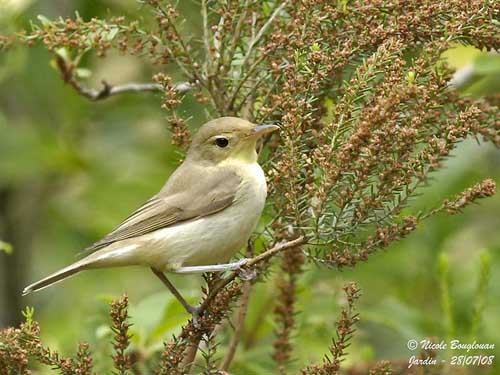
RANGE:
The Melodious Warbler is a monotypic species.
It breeds in France (except in N parts) and Iberia, E to S Belgium, SW Germany, Switzerland, Italy, Slovenia and W Croatia, and in NW Africa.
It winters in W Africa, from Gambia and Senegal, E to Nigeria and Cameroon.
HABITAT:
The Melodious Warbler frequents well wooded savannas and mangroves in Africa. On the breeding grounds, it frequents maquis, orchards, large gardens, scrub, dense thorny bushes in meadows, forest edges, pastures and riverine forest.
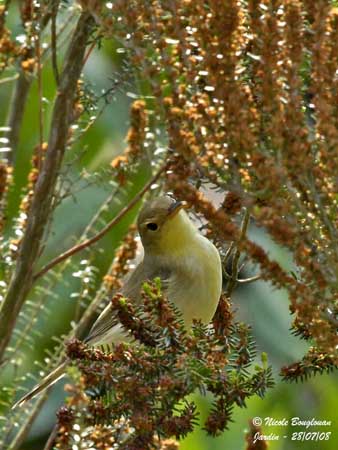
CALLS AND SONGS: SOUNDS BY XENO-CANTO
The Melodious Warbler utters varied calls, tongue-clicking “chek” notes, Sparrow-like “chrrrt” calls, and clicking notes “tre-te-te-te” or “te-te-te-te-te” given in series.
The song is a warble of varying speed and length. We can usually hear a drawn-out phrase including nasal notes and chattering “tr’r’r’r’r’r’r’rt”, sometimes slower. It also performs some mimicry of other birds.
The Melodious Warbler is rather silent on passage, but it sings quite frequently in winter areas and around periods of arrival and departure.
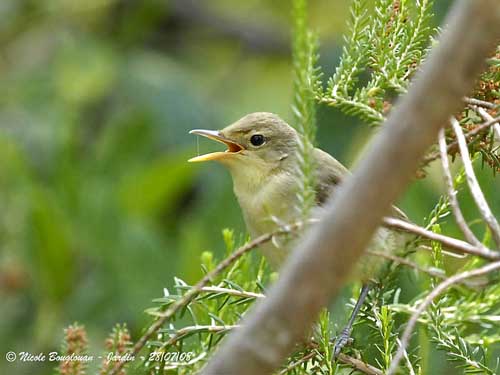
BEHAVIOUR IN THE WILD:
The Melodious Warbler feeds primarily on insects and invertebrates such as flies, grasshoppers, bugs, moths, butterflies, ants, beetles, caterpillars and spiders.
It also consumes plant food, including fruits and berries in summer such as Rubus, Prunus, Sambucus and Ficus.
It is very active when foraging in dense bushes and tree canopy while searching for preys. It catches them very quickly once located, thanks to the long, broad bill and the large rictal bristles. It grasps the prey with quick movements but rarely hovers.
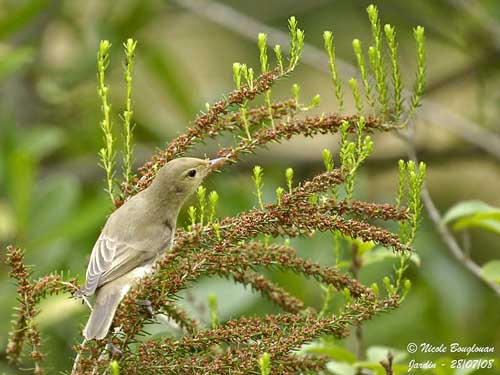
The Melodious Warbler is often seen alone, but it may join sometimes mixed-species foraging groups in open woodlands. It often moves quietly under the leafy cover. It frequently waves the tail from side to side or moves it up and down.
During the breeding season, the Melodious Warbler is territorial and monogamous. Interactions may occur, involving threat displays, intense songs and calls, chasing and fighting.
Song flights are frequent in courtship behaviour. The male also sings from high perch and for long time, often several hours with short pauses.
During the flight displays, the male rises into the air while singing, before to descend with broadly open wings. It perches at the end of a high branch in tree. The female remains silent and hidden in the vegetation. Later, the male performs mate-guarding while she builds the nest.
The Melodious Warbler is migratory and moves S to winter in Africa. It leaves the breeding grounds from late July to early September, and reaches the wintering areas between September and November. It remains there until late February/April, and returns to its breeding grounds in late April/May.
It has an agile flight and is a high-performance flier, thanks to the wing adapted to high speed and manoeuvrability. Such wings are rather long with moderately long primary projection and are bluntly pointed.
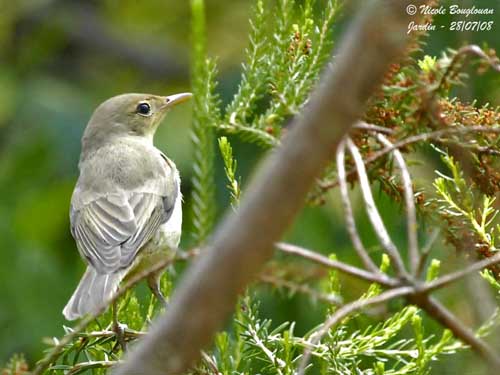
REPRODUCTION OF THIS SPECIES:
The breeding season occurs from May to July, and this species produces a single brood, sometimes two in South.
The female builds the nest, a robust cup made with grasses, stems and twigs, often covered with bark and lichens attached together with spider webs. The inner cup is lined with plant fibres, roots and fur or other soft materials. The nest is placed in fork of branch, between 0, 5 and 5 metres above the ground.
The female lays 4-5 pinkish to purplish eggs with small dark spots. She incubates during 12-13 days. The chicks are fed by both parents. They fledge about 11-13 days after hatching, but they remain hidden in the surrounding vegetation, begging for food. The male defends strongly the nest-site.
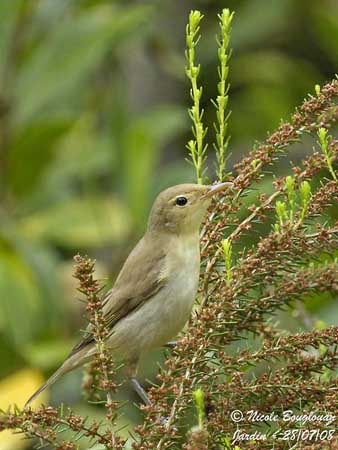
PROTECTION / THREATS / STATUS:
The Melodious Warbler is locally to very common throughout the range, and common too in most parts of the wintering areas. This species is not currently threatened.
